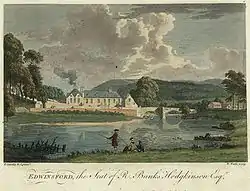Sir Nicholas Williams, 1st Baronet
Sir Nicholas Williams, 1st Baronet (1681 – 19 July 1745) was a British politician.

He was the eldest son of Sir Rice Williams, of Edwinsford, Carmarthenshire, by his second wife, Mary Vaughan, daughter and co-heir of John Vaughan of Llanelly. He was educated at Eton College and Queens' College, Cambridge.[1]
He was High Sheriff of Carmarthenshire from 1697–98, and was created a baronet on 30 July 1707.[2] From 1724 until his death, he was a Member of Parliament for Carmarthenshire in the Parliament of Great Britain, and was Lord Lieutenant of the county from 1735 to 1740. He was a supporter of Robert Walpole.[1]
He married Mary Cocks, the daughter of Charles Cocks and niece of John Somers, 1st Baron Somers, on 19 June 1712 at St Mildred, Poultry, London. They had no children, and the baronetcy became extinct on his death in 1745. His estate eventually devolved to the second and third Hamlyn-Williams baronets.[2]
After his death, his brother Thomas took over as Custos Rotulorum of Carmarthenshire.[3]
Armorials
The arms of Williams of Edwinsford are: Argent, a lion rampant sable, face, paws & tuft of the tail of the field.[4]
References
- Thomas, Peter D. G. (1970) "WILLIAMS, Sir Nicholas, 1st. Bt. (1681–1745), of Edwinsford, Carm." in The History of Parliament: the House of Commons 1715–1754, ed. Romney Sedgwick
- Cokayne, George Edward (1906) Complete Baronetage. Volume V. Exeter: W. Pollard & Co. LCCN 06-23564. pp. 4–5
- "The British Chronologist: Comprehending Every Material Occurrence, Ecclesiastical, Civil, or Military, Relative to England and Wales, from the Invasion of the Romans to the Present Time". 1775.
- Debrett's Baronetage of England, 6th edition, Vol.2, London, 1828, pp.490-1
| Parliament of Great Britain | ||
|---|---|---|
| Preceded by Edward Rice |
Member of Parliament for Carmarthenshire 1724–1745 |
Succeeded by John Vaughan |
| Baronetage of Great Britain | ||
| New creation | Baronet (of Edwinsford) 1707–1745 |
Extinct |